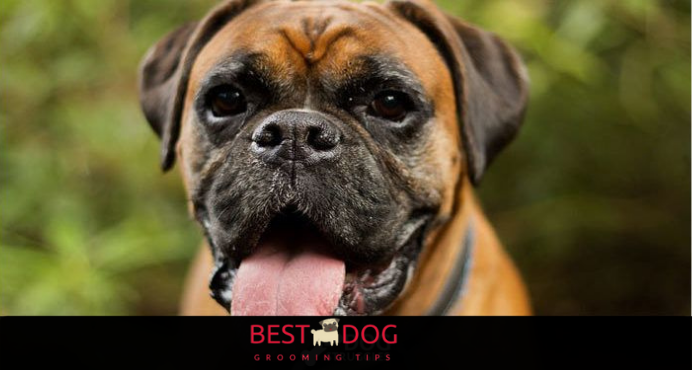This square-jawed, friendly, and active breed can be the best guard dog as well as a family companion if you have the right hand to harness its high energy. Like every other breed, they have their own personality traits, ways of handling which you might need to know before you own a boxer.
Today’s discussion will include everything about boxer from the history of the breed to their feeding and grooming style so that you know what to do right after you get a boxer. Treat them with care and they will show the sign of ultimate love and loyalty towards you and your family. Let’s get started.
History Of The Boxer
Today’s boxer has come into the play in the near past, back in the 19th century, and is mostly bred for guarding. Though their ancestors, now extinct German Bullenbeisser used to be hunter dogs and hunt wild animals for their masters, boxers are used as guard dogs.
Their predecessors worked in the military during World War I to serve the role of messenger dogs, attach and guard dogs, etc. and became popular in the US after World War II, credit of which goes to the returning soldiers who brought Boxer mascots to show people their love for this breed.
From them, boxers are still very popular across the world for their loving personality, agile activeness, and ability to adapt to almost any environment unless it is too harsh. American Kennel Club has recognized this breed as a working dog back in 1904 and boxers hold the 7th rank among 155 breeds that are accepted by AKC.
Appearance
Boxer is a spectacular breed with a height of 25 inches for the male and 23 inches for the female. The weight also differs from male to female, making male boxers the heaviest at 65 to 80 pounds and female boxers lighter at 50 to 65 pounds.
This breed is easily recognizable by its distinct square jaw and a blunt muzzle. Also, the chest is deeper and broader than many other breeds which gives them a muscular look to be perfect for a working dog. But the back of the boxer is shorter compared to other breeds giving them high stability while walking or running.
You will find the ears are naturally floppy that tend to fold over but often they are clipped to stand erect which gives the boxers a more agile look while guarding. The tails are usually docked upwards.
Their stocky and muscular body is covered with a short coat that is prone to shedding in the spring. Most of the boxers are either fawn or brindle in color and have a black marking around their face and nose called the mask.
But due to the lack of a specific gene, boxers aren’t seen to be completely black. Some of them might be white too, but that isn’t the general case. With a compact and muscular body, this breed is a powerhouse of energy that you can guide in the right direction to be benefited.
Personality
Though Boxers fall under the working dog category according to the classification of the AKC, they are mainly guarding dogs. Their alertness and high activity level make them the right candidate for this job. So, whenever a boxer is in the watch, you can be assured of safety.
But when they aren’t guarding your house, they must be playing with you and your family or clowning themselves. Their aggressive character gets expressed when someone unknown wants to intrude on their territory but they’re very friendly to familiar people. So, before you employ a boxer in their job, make sure he is familiar with the members of your house.
This personality builds up gradually as the boxer grows. And it takes up to three years for a boxer to be an adult. During this puppyhood, they need to go through rigorous training and socialization to be the perfect companion for you and your family.
Exposing them to the outer world enriches their personality to a great extent where they learn how to behave with other humans and dogs, so take them outside to introduce them to your friends and neighbors to increase the consciousness of the dog.
Temperament
Boxers are happy and loyal dogs provided that you give them a lot of activities that burn their energies to keep them healthy and fit. This fun-loving creature often amuses people with their enchanting behavior but gets agile while on duty. So, the temperament is a bit confusing to adjust.
But, once you are familiar with the boxer temperament, you will love it even more and the dog will be loyal to you no matter what happens. If you aren’t providing plenty of exercises to the dog, it can get unnecessarily aggressive and start barking a lot which can be disturbing.
Also, keep an eye on the dog while playing with small kids, as both the dog and the kid can get injured as a result of jumping and running. They make a very good playmate but at puppyhood, they shouldn’t be jumping high for long otherwise they can get hurt.
Health Issues
Like almost every other breed, Boxers are prone to a few health issues that need to be taken care of. Some of them might be easy to treat while some others might not be curable. Some of these issues are hereditary and can’t be cured. So, choosing a healthy puppy from a renowned breeder is the first option to choose.
As the puppy grows, you should continuously be checking the puppy for any unusual behavior or reaction, and take it to a licensed vet can help solve the problem at a primary stage. Here are some of the most common health issues about boxer.
Hip Dysplasia is one of the most common diseases in many dog breeds, which is also present in boxers hereditarily. As this comes from the parent, the best thing to do is check a boxer before breeding. Any dog with this problem shouldn’t be used for breeding.
But, if you see the sign of hip dysplasia at the adult age including the pain and lameness showed by some dogs, go to your veterinarian for further checkup. Then the dog can be treated in different ways, from medication to surgery.
Hypothyroidism, a disease caused by the deficiency of thyroid hormone is also common in boxers and can cause infertility, obesity, etc. There can be other signs like the skin becoming dark and the coat becoming brittle. Consult a veterinarian for the right medication to fight hypothyroidism to keep your dog healthy and happy for the rest of the life.
Boxers are also prone to different cancers, skin cancer being the most common. Don’t let your boxer be exposed to direct sunlight for a longer period which can cause skin cancer. Allergies are also common in boxers.
Allergies are mostly caused by food allergens, so check for any irregularity on their skin or behavior against certain food items in your boxer’s diet. Make a balanced diet plan with the help of a professional nutritionist to make sure your dog is eating happily.
Deafness can also be a common problem that has no effective treatment. And, deafness comes hereditarily most of the time. So, it is better to be assured by the breeder that your dog is free from these diseases.
Food
No matter what the size or age is, high-quality food is a must for your boxer. But there will be variations in the amount of food depending on the size, activity level, and age of your dog. We suggest you buy the best quality food for your dog for better nourishment and healthy life.
Make your boxer get used to eating from the food bowl placed at a certain spot whether inside or outside the house. But don’t leave the food bowl all day long as it can lure the dog to eat whenever he wants. It is important to give the dog two meals a day to keep it fit. Once the dog is familiar with the feeding schedule, it will be easy for the dog to eat and digest.
The food you are producing to the dog should be free from any allergic items. It is the best practice to make a balanced diet chart from the nutritionist to make sure your dog is getting all the necessary nutrients to live a healthy life.
Sticking to the feeding schedule is important as overeating might cause obesity for your dog. So, get it busy with plenty of training and exercise to burn off the extra energy.
Training And Exercise
Boxers are playful. They just love to take loads of physical exercise and mental stimulation. So, you should be the one in control so that the dog doesn’t overdo it. But underdoing this also creates problems such as making the dog unnecessarily destructive.
If you have a backyard fenced, it can be the best leisure spot for your boxer as they would love to play around until they get tired. The more tired they are, the happier they will be. But if you are taking them for a walk to the nearby parks, be extra careful to hold a strong harness as they can get out of control quite easily.
Train your boxer to treat humans and other dogs gently from a very young age. As the puppyhood of the boxers lasts longer than most other breeds, starting this training from at least one year of age is recommended otherwise the puppy can get hurt or develop hip dysplasia due to excess pressure on the joints.
Positive training methods work the best with boxers as they are fond of attention and care. Play fetch or flyball and treat them with their favorite food or praise them to make them happy instantly. This also increases their eagerness to training sessions which will result in a gentle and intelligent adult boxer.
Care And Grooming
Boxers tend to have a shorter coat than many other breeds laid over the tight skin. This makes the grooming a lot easier and you need to worry less about frequent grooming sessions. Still, you need some routine grooming work to be done from time to time to make sure your dog is in tiptop condition.
Boxers usually shed less than other breeds due to their short coat but when they shed, you need to be brushing them with a bristle brush to get rid of the excess hair and keep the coat tangle-free. Rubbing the coat with a hard rubber can increase the sheen of the coat if done regularly which looks great.
Boxers usually stay clean most of the time and can groom themselves on their own. But if they catch excess dirt while playing outdoor, you need to give them a bath to remove the dirt and debris from their body. Bathing your dog regularly also keeps them away from any unwanted germs.
Trimming the nails regularly is crucial as long nails can break down while dogs are playing or running. This can hurt the dog as well as hurt you when the dog jumps on you. To prevent dirt from building up inside the nails, get a good nail clipper and trim the nails once you see that they are big enough.
Brush your boxer’s teeth regularly to get rid of bacteria and get your dog used to brushing from an early age. Not only brushing but you also need to make the dog familiar with grooming sessions so that it doesn’t revolt while grooming as an adult.
It is important to thoroughly check your dog for any irregularity like sores, rashes, redness, or other signs of infection during the grooming session. If anything unusual is spotted, rush to the vet for an extensive checkup and further treatment.
Final Words
Almost everything about boxer is covered here and you are now almost ready to be the parent of a cute, little boxer pooch. Get a healthy puppy from a good breeder, start caring for it from the beginning and continue as it grows to get an intelligent, loving, and loyal companion for life.












